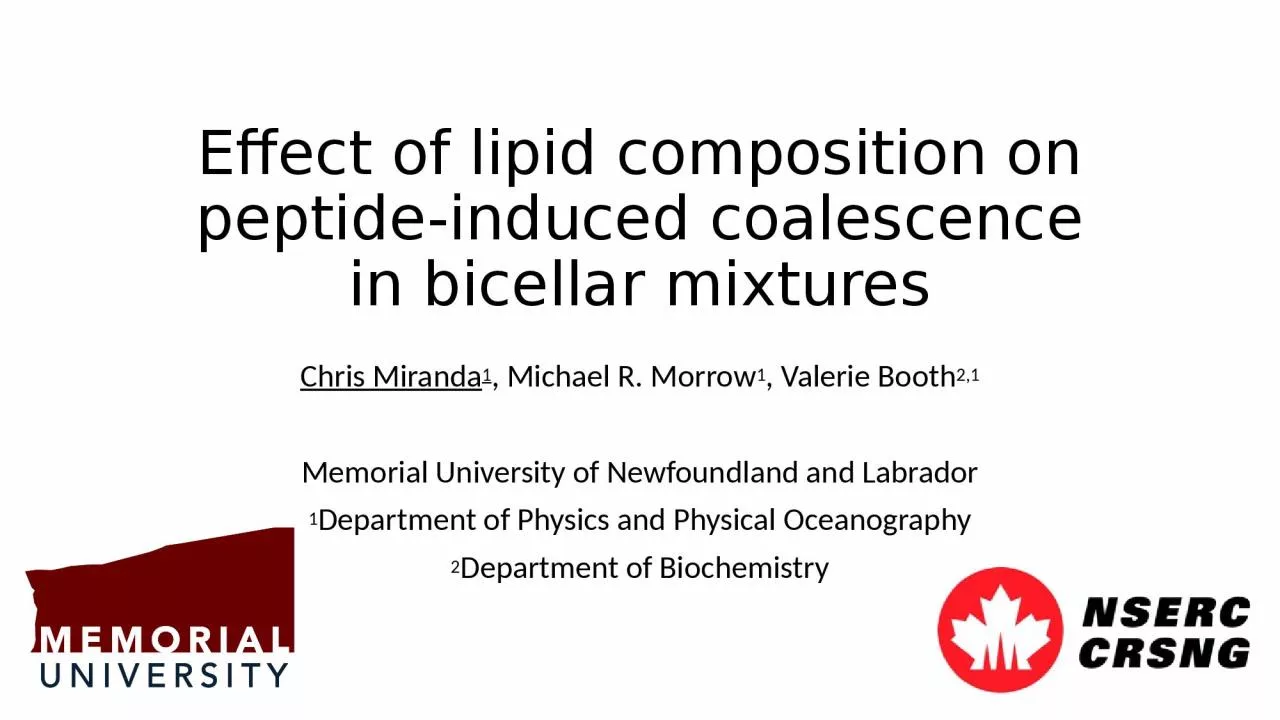

bicellar mixtures Chris Miranda 1 Michael R Morrow 1 Valerie Booth 21 Memorial University of Newfoundland and Labrador 1 Department of Physics and Physical Oceanography 2 Department of Biochemistry ID: 1021831
Download Presentation The PPT/PDF document "Effect of lipid composition on peptide-i..." is the property of its rightful owner. Permission is granted to download and print the materials on this web site for personal, non-commercial use only, and to display it on your personal computer provided you do not modify the materials and that you retain all copyright notices contained in the materials. By downloading content from our website, you accept the terms of this agreement.
1. Effect of lipid composition on peptide-induced coalescence in bicellar mixturesChris Miranda1, Michael R. Morrow1, Valerie Booth2,1Memorial University of Newfoundland and Labrador1Department of Physics and Physical Oceanography2Department of Biochemistry
2. Protein-Lipid InteractionsPerturbation of bilayers by peptides can be important in many biological contexts. For example:Lung surfactantAntimicrobial activityThis Study:Compare effects of a lung surfactant peptide fragment and an antimicrobial peptide on a membrane model system (bicellar dispersions) whose organization is very sensitive to perturbing interactionsAsk: Do two peptides (both cationic and amphipathic but apparently different functionally) perturb the model system differently?Is the observed perturbation sensitive to bilayer composition (i.e. anionic lipid content)?
3. Surfactant Protein Bairfluidmultilayerstubular myelinlamellar bodiestype II alveoliAlveolar FunctionH3N+-GR+MLPQLVCR+LVLR+CS-COO-Surfactant Protein BSP-B:79 residue monomerCationic (+7), amphipathic, mainly hydrophobicSP-BC-TERMAmphipathic α-helixCationic (+3), mainly hydrophobicRetains some functionality of full length SP-B
4. Magainin 2Amphipathic α-helixCationic (+4) and hydrophobicSuggested to disrupt membrane via pore formationPDBID: 2MAGGesell, J. . Z. M. . O. S. J. (1997). Two-dimensional 1H NMR experiments show that the 23-residue magainin antibiotic peptide is an alpha-helix in dodecylphosphocholine micelles, sodium dodecylsulfate micelles, and trifluoroethanol/water solution. J.Biomol.NMR, 9, 127–135.
5. Bicellar MixturesMixtures of long chain and short chain lipidsCoalesce to larger structures upon warmingIsotropic PhaseMagnetically Oriented PhaseExtended Lamellar Phase21Low TemperatureHigh Temperature
6. 2H NMR of Bicelles212H NMR distinguishes bicelle phases2H NMR Deuteron splittings reflect motional averaging of orientational dependent quadrupole interaction
7. Zwitterionic Bicellar Mixtures with/without SP-BC-TERM 2121DMPC-d54 /DHPCSP-BC-TERM has little effect on transitions in mixtures of DMPC/DHPC (both zwitterionic) DMPC-d54/DMPC/DHPC (3:1:1)DMPC-d54/DMPC/DHPC (3:1:1)With 10% SP-BC-TERM (w/w)
8. SP-BC-TERM and Bicellar Mixtures with Anionic Lipids2121DMPC-d54 /DMPG/DHPCIn lipid-only bicellar mixtures, anionic lipid lowers and sharpens the ribbon-to-extended lamellar transition.SP-BC-TERM further lowers the ribbon-to-extended lamellar transitionImplies that SP-BC-TERM depends on the presence of anionic lipids to promote ribbon-micelle coalescenceDMPC-d54/DMPG/DHPC (3:1:1)DMPC-d54/DMPG/DHPC (3:1:1)With 10% SP-BC-TERM (w/w)
9. Does SP-BC-TERM segregate DMPG?2121DMPC /DMPG-d54/DHPCDMPG-d54 and DMPC-d54 report similar behavioursDMPC/DMPG-d54/DHPC (3:1:1)DMPC/DMPG-d54/DHPC (3:1:1)With 10% SP-BC-TERM (w/w)DMPC-d54/DMPG/DHPC (3:1:1)DMPC-d54/DMPG/DHPC (3:1:1)With 10% SP-BC-TERM (w/w)
10. How does Magainin 2 affect bicellar phase behaviour?2121DMPC-d54 /DMPG/DHPCAddition of Magainin 2 appeared to reverse the effect of DMPG on bicellar mixture phase behaviour Spectra similar to DMPC-d54/DHPC (4:1) bicellesPeptide-induced segregation of DMPG?DMPC-d54/DMPG/DHPC (3:1:1)DMPC-d54/DMPG/DHPC (3:1:1)With 10% Magainin 2 (w/w)DMPC-d54/DMPG/DHPC (3:1:1)DMPC-d54/DMPG/DHPC (3:1:1)With 10% SP-BC-TERM (w/w)
11. DMPC and DMPG appear to be in different environments in bicellar mixtures with Magainin 22121DMPC /DMPG-d54/DHPCSpectra suggest that Magainin 2 interaction promotes a distinct environment for DMPG (anionic lipid)Peptide-induced clustering anionic lipids?DMPC/DMPG-d54/DHPC (3:1:1)DMPC/DMPG-d54/DHPC (3:1:1)With 10% Magainin 2 (w/w)
12. ConclusionsPeptide-induced reorganization of bicellar mixtures appears to be facilitated by the presence of anionic lipidSP-BC-TERMPromotes ribbon-to-extended lamellar coalescence at a lower temperature when anionic lipids are presentDoes not appear to involve separation of DMPG and DMPCMagainin 2Appears to preferentially interact with anionic lipidsSpectra suggest separation of anionic lipids, possibly clustering
13. AcknowledgementsSupervisor: Michael R. MorrowGroup Members: Gagandeep SandhuSuhad SbeihCollin KnightCollaborators:Valerie BoothDonna JackmanFunding Provided by: